Anoectochilus roxburghii Extract Extends the Lifespan of Caenorhabditis elegans through Activating the daf-16/FoxO Pathway
Abstract
:1. Introduction
2. Materials and Methods
2.1. Reagents and Materials
2.2. Preparation and Identification of AREs
2.3. Culture and Treatment of C. elegans
2.4. Lifespan Analysis
2.5. Lipofuscin Level Assay
2.6. Stress Tolerance Tests
2.7. Determination of ROS and Antioxidant Enzymes
2.8. RNA-seq
2.9. Metabonomics
2.10. Real-Time Quantitative PCR
2.11. Nuclear Localization of DAF-16
2.12. Quantitation of GST-4::GFP and SOD-3::GFP Expression
3. Results
3.1. Screening and Identification of Active Substances from A. roxburghii
3.2. ARE Did Not Affect Food Selection, Proliferation, and Development of C. elegans
3.3. ARE Reduced the Accumulation of Lipofuscin and Prolonged the Life Span of C. elegans
3.4. ARE Enhanced the Stress Resistance of C. elegans
3.5. ARE Increased Antioxidant Enzyme Activity and Decreased ROS Accumulation in C. elegans
3.6. RNA-Seq and Enrichment Analysis
3.7. Metabolomics Analysis
3.8. Integration of Transcriptomics and Metabolomics Networks in C. elegans
3.9. ARE Upregulated the Expression Levels of the daf-16, sod-3, and gst-4
3.10. ARE Prolongs the Lifespan of C. elegans through the daf-16/FoxO Pathway
4. Discussion
Author Contributions
Funding
Institutional Review Board Statement
Data Availability Statement
Conflicts of Interest
Appendix A. Anoectochilus roxburghii Extract Extends the Lifespan of Caenorhabditis elegans through Activating the daf-16/FoxO Pathway
Appendix A.1. Extraction Method for A. roxburghii
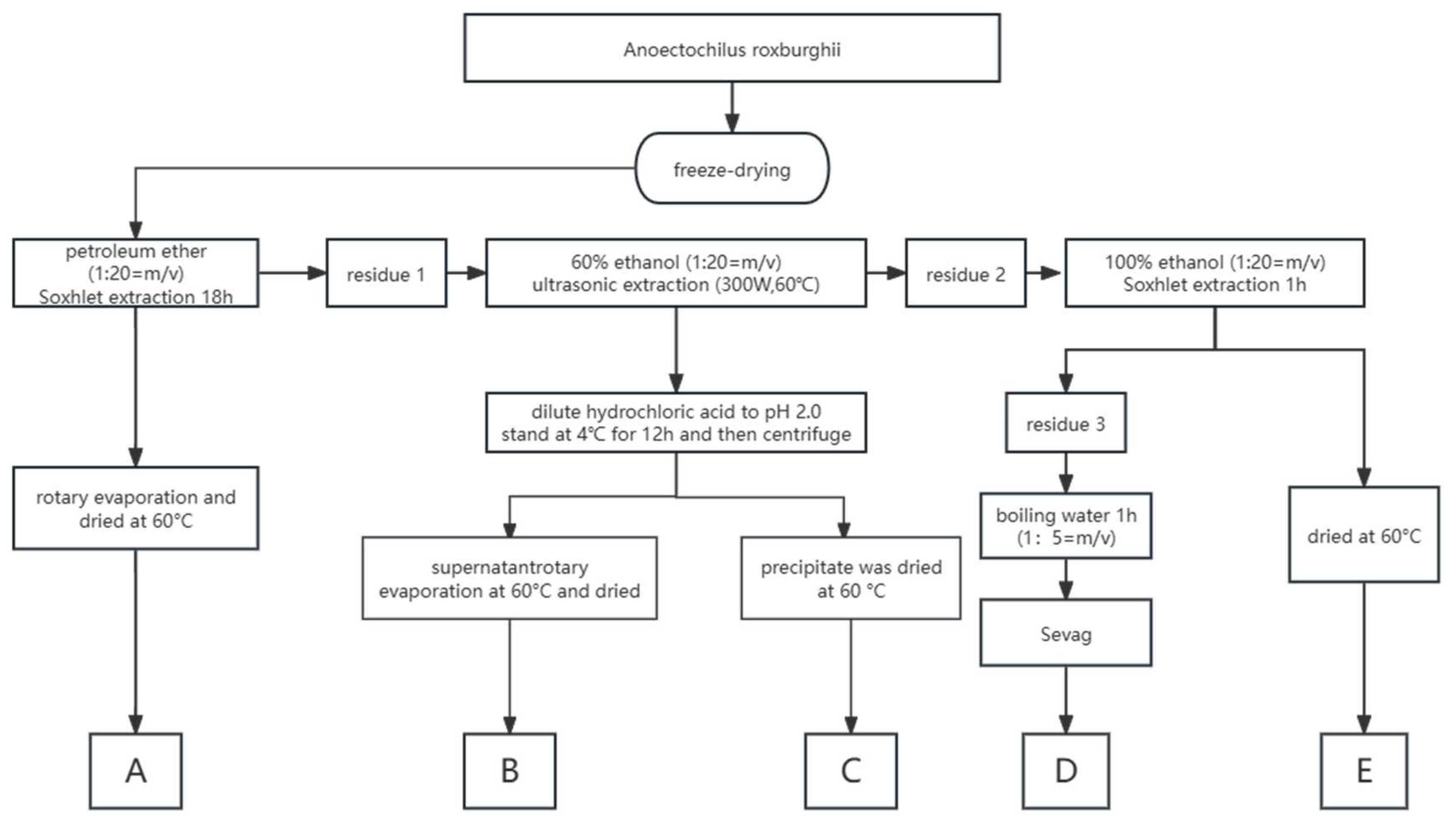
Appendix A.2. DPPH Radical Scavenging Assay of Extracts
- A1 is the absorbance of 3 mL sample + 1 mL DPPH.
- A2 is the absorbance of 3 mL sample solvent + 1 mL DPPH.
- A3 is the absorbance of 3 mL sample + 1 mL ethanol.
Appendix A.3. ABTS Radical Scavenging Assay
| Anoectochilus roxburghii Extract | DPPH (IC50) | ABTS (IC50) |
|---|---|---|
| A | 0.2068 mg/mL | 4.872 mg/mL |
| B | 0.2692 mg/mL | 5.942 mg/mL |
| C | 0.0488 mg/mL | 2.107 mg/mL |
| D | 0.1471 mg/mL | 9.961 mg/mL |
| E | 0.0319 mg/mL | 0.8797 mg/mL |

References
- Borghesan, M.; Hoogaars, W.M.H.; Varela-Eirin, M.; Talma, N.; Demaria, M. A Senescence-Centric View of Aging: Implications for Longevity and Disease. Trends Cell. Biol. 2020, 30, 777–791. [Google Scholar] [CrossRef] [PubMed]
- Childs, B.G.; Durik, M.; Baker, D.J.; van Deursen, J.M. Cellular senescence in aging and age-related disease: From mechanisms to therapy. Nat. Med. 2015, 21, 1424–1435. [Google Scholar] [CrossRef] [PubMed]
- van Deursen, J.M. The role of senescent cells in ageing. Nature 2014, 509, 439–446. [Google Scholar] [CrossRef] [PubMed]
- Duan, H.; Pan, J.; Guo, M.; Li, J.; Yu, L.; Fan, L. Dietary strategies with anti-aging potential: Dietary patterns and supplements. Food Res. Int. 2022, 158, 111501. [Google Scholar] [CrossRef] [PubMed]
- Ley, S.H.; Romrell, A.M. Healthy eating for healthy aging: What and when to eat as an older adult. Am. J. Clin. Nutr. 2022, 116, 293–294. [Google Scholar] [CrossRef] [PubMed]
- Wang, B.; Tang, X.; Mao, B.; Zhang, Q.; Tian, F.; Zhao, J.; Cui, S.; Chen, W. Anti-aging effects and mechanisms of anthocyanins and their intestinal microflora metabolites. Crit. Rev. Food Sci. Nutr. 2024, 64, 2358–2374. [Google Scholar] [CrossRef] [PubMed]
- Peixoto, H.; Roxo, M.; Krstin, S.; Röhrig, T.; Richling, E.; Wink, M. An Anthocyanin-Rich Extract of Acai (Euterpe precatoria Mart.) Increases Stress Resistance and Retards Aging-Related Markers in Caenorhabditis elegans. J. Agric. Food Chem. 2016, 64, 1283–1290. [Google Scholar] [CrossRef] [PubMed]
- Yun, Y.R.; Park, B.Y.; Kim, S.H.; Jung, J.H. Antioxidant, Anti-Obesity, and Anti-Aging Activities of Jeju Citrus Blended Vinegar. Foods 2021, 10, 1441. [Google Scholar] [CrossRef] [PubMed]
- Zheng, W.V.; Xu, W.; Li, Y.; Qin, J.; Zhou, T.; Li, D.; Xu, Y.; Cheng, X.; Xiong, Y.; Chen, Z. Anti-aging effect of β-carotene through regulating the KAT7-P15 signaling axis, inflammation and oxidative stress process. Cell. Mol. Biol. Lett. 2022, 27, 86. [Google Scholar] [CrossRef]
- Shen, P.; Yue, Y.; Park, Y. A living model for obesity and aging research: Caenorhabditis elegans. Crit. Rev. Food Sci. Nutr. 2018, 58, 741–754. [Google Scholar] [CrossRef]
- Denzel, M.S.; Lapierre, L.R.; Mack, H.I.D. Emerging topics in C. elegans aging research: Transcriptional regulation, stress response and epigenetics. Mech. Ageing Dev. 2019, 177, 4–21. [Google Scholar] [CrossRef] [PubMed]
- Murphy, C.T.; Hu, P.J. Insulin/insulin-like growth factor signaling in C. elegans. WormBook 2013, 1–43. [Google Scholar] [CrossRef] [PubMed]
- Zečić, A.; Braeckman, B.P. DAF-16/FoxO in Caenorhabditis elegans and Its Role in Metabolic Remodeling. Cells 2020, 9, 109. [Google Scholar] [CrossRef] [PubMed]
- Sun, X.; Chen, W.D.; Wang, Y.D. DAF-16/FOXO Transcription Factor in Aging and Longevity. Front. Pharmacol. 2017, 8, 548. [Google Scholar] [CrossRef] [PubMed]
- Qi, Z.; Ji, H.; Le, M.; Li, H.; Wieland, A.; Bauer, S.; Liu, L.; Wink, M.; Herr, I. Sulforaphane promotes C. elegans longevity and healthspan via DAF-16/DAF-2 insulin/IGF-1 signaling. Aging 2021, 13, 1649–1670. [Google Scholar] [CrossRef] [PubMed]
- Song, B.; Zheng, B.; Li, T.; Liu, R.H. Raspberry extract promoted longevity and stress tolerance via the insulin/IGF signaling pathway and DAF-16 in Caenorhabditis elegans. Food Funct. 2020, 11, 3598–3609. [Google Scholar] [CrossRef] [PubMed]
- Jiang, S.; Deng, N.; Zheng, B.; Li, T.; Liu, R.H. Rhodiola extract promotes longevity and stress resistance of Caenorhabditis elegans via DAF-16 and SKN-1. Food Funct. 2021, 12, 4471–4483. [Google Scholar] [CrossRef] [PubMed]
- Ye, S.; Shao, Q.; Zhang, A. Anoectochilus roxburghii: A review of its phytochemistry, pharmacology, and clinical applications. J. Ethnopharmacol. 2017, 209, 184–202. [Google Scholar] [CrossRef] [PubMed]
- Deng, Y.F.; Xu, Q.Q.; Chen, T.Q.; Ming, J.X.; Wang, Y.F.; Mao, L.N.; Zhou, J.J.; Sun, W.G.; Zhou, Q.; Ren, H.; et al. Kinsenoside alleviates inflammation and fibrosis in experimental NASH mice by suppressing the NF-κB/NLRP3 signaling pathway. Phytomedicine 2022, 104, 154241. [Google Scholar] [CrossRef]
- Zeng, B.; Su, M.; Chen, Q.; Chang, Q.; Wang, W.; Li, H. Anoectochilus roxburghii polysaccharide prevents carbon tetrachloride-induced liver injury in mice by metabolomic analysis. J. Chromatogr. B Anal. Technol. Biomed. Life Sci. 2020, 1152, 122202. [Google Scholar] [CrossRef]
- Zeng, B.; Su, M.; Chen, Q.; Chang, Q.; Wang, W.; Li, H. Antioxidant and hepatoprotective activities of polysaccharides from Anoectochilus roxburghii. Carbohydr. Polym. 2016, 153, 391–398. [Google Scholar] [CrossRef] [PubMed]
- Yang, Z.; Zhang, X.; Yang, L.; Pan, Q.; Li, J.; Wu, Y.; Chen, M.; Cui, S.; Yu, J. Protective effect of Anoectochilus roxburghii polysaccharide against CCl4-induced oxidative liver damage in mice. Int. J. Biol. Macromol. 2017, 96, 442–450. [Google Scholar] [CrossRef] [PubMed]
- Xiao, Y.; Duan, C.; Gong, P.; Zhao, Q.; Wang, X.H.; Geng, F.; Zeng, J.; Luo, T.; Xu, Y.; Zhao, J. Kinsenoside from Anoectochilus roxburghii (Wall.) Lindl. suppressed oxidative stress to attenuate aging-related learning and memory impairment via ERK/Nrf2 pathway. J. Ethnopharmacol. 2024, 319, 117152. [Google Scholar] [CrossRef] [PubMed]
- Tang, T.; Duan, X.; Ke, Y.; Zhang, L.; Shen, Y.; Hu, B.; Liu, A.; Chen, H.; Li, C.; Wu, W.; et al. Antidiabetic activities of polysaccharides from Anoectochilus roxburghii and Anoectochilus formosanus in STZ-induced diabetic mice. Int. J. Biol. Macromol. 2018, 112, 882–888. [Google Scholar] [CrossRef] [PubMed]
- Stiernagle, T. Maintenance of C. elegans. WormBook 2006, 1–11. [Google Scholar] [CrossRef] [PubMed]
- Lu, L.; Xiong, Y.; Lin, Z.; Chu, X.; Panayi, A.C.; Hu, Y.; Zhou, J.; Mi, B.; Liu, G. Advances in the therapeutic application and pharmacological properties of kinsenoside against inflammation and oxidative stress-induced disorders. Front. Pharmacol. 2022, 13, 1009550. [Google Scholar] [CrossRef] [PubMed]
- Orea-Soufi, A.; Paik, J.; Bragança, J.; Donlon, T.A.; Willcox, B.J.; Link, W. FOXO transcription factors as therapeutic targets in human diseases. Trends Pharmacol. Sci. 2022, 43, 1070–1084. [Google Scholar] [CrossRef] [PubMed]
- Calissi, G.; Lam, E.W.; Link, W. Therapeutic strategies targeting FOXO transcription factors. Nat. Rev. Drug Discov. 2021, 20, 21–38. [Google Scholar] [CrossRef] [PubMed]
- Tissenbaum, H.A. DAF-16: FOXO in the Context of C. elegans. Curr Top. Dev. Biol. 2018, 127, 1–21. [Google Scholar] [CrossRef]
- Ji, H.; Qi, Z.; Schrapel, D.; Le, M.; Luo, Y.; Yan, B.; Gladkich, J.; Schaefer, M.; Liu, L.; Herr, I. Sulforaphane Targets TRA-1/GLI Upstream of DAF-16/FOXO to Promote C. elegans Longevity and Healthspan. Front. Cell. Dev. Biol. 2021, 9, 784999. [Google Scholar] [CrossRef]
- Duangjan, C.; Rangsinth, P.; Gu, X.; Zhang, S.; Wink, M.; Tencomnao, T. Glochidion zeylanicum leaf extracts exhibit lifespan extending and oxidative stress resistance properties in Caenorhabditis elegans via DAF-16/FoxO and SKN-1/Nrf-2 signaling pathways. Phytomedicine 2019, 64, 153061. [Google Scholar] [CrossRef] [PubMed]
- Wang, S.; Lin, D.; Cao, J.; Wang, L. APPA Increases Lifespan and Stress Resistance via Lipid Metabolism and Insulin/IGF-1 Signal Pathway in Caenorhabditis elegans. Int. J. Mol. Sci. 2023, 24, 3682. [Google Scholar] [CrossRef] [PubMed]
- Yurekten, O.; Payne, T.; Tejera, N.; Amaladoss, F.X.; Martin, C.; Williams, M.; O’Donovan, C. MetaboLights: Open data repository for metabolomics. Nucleic Acids Res. 2024, 52, D640–D646. [Google Scholar] [CrossRef] [PubMed]
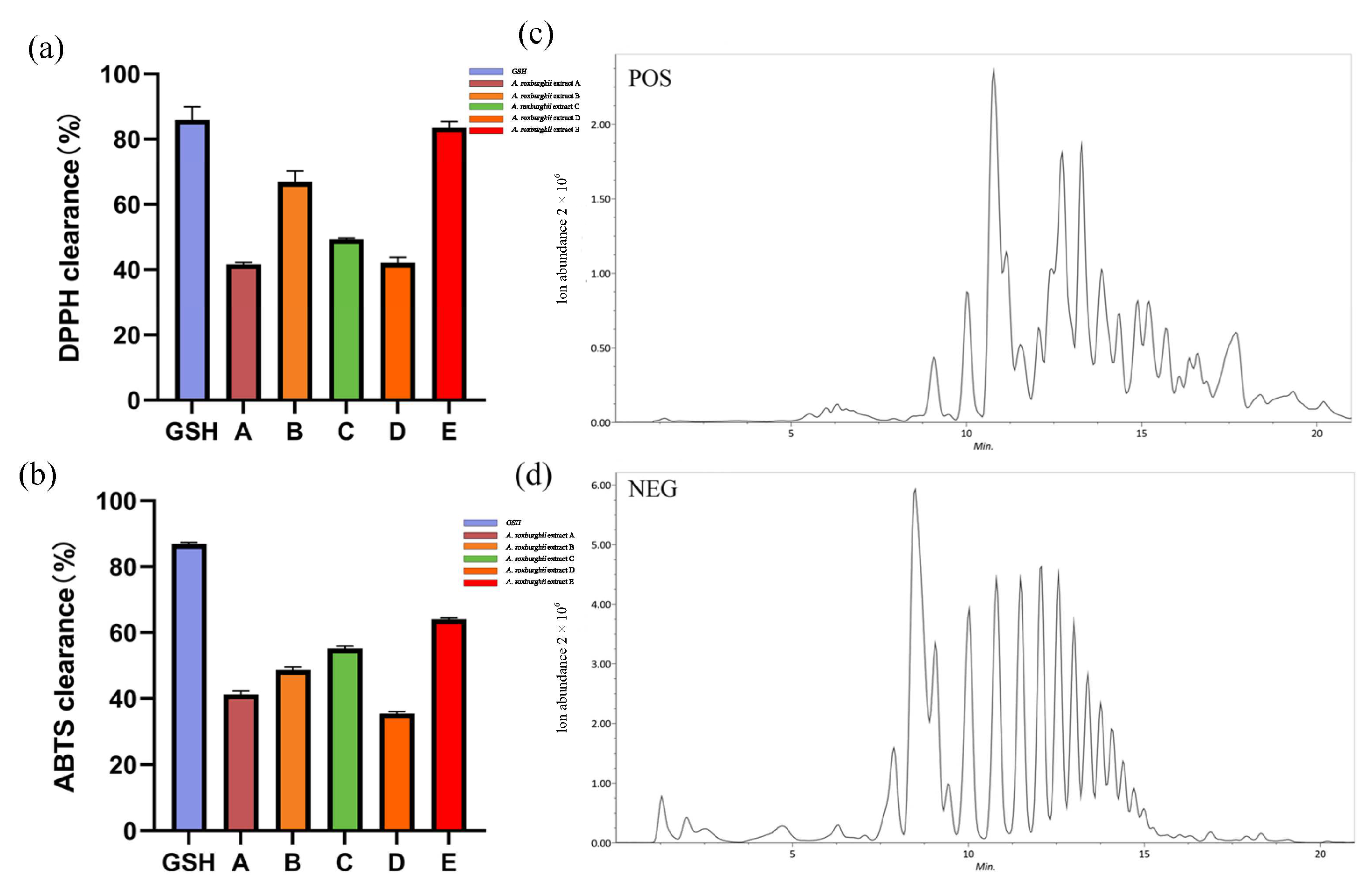

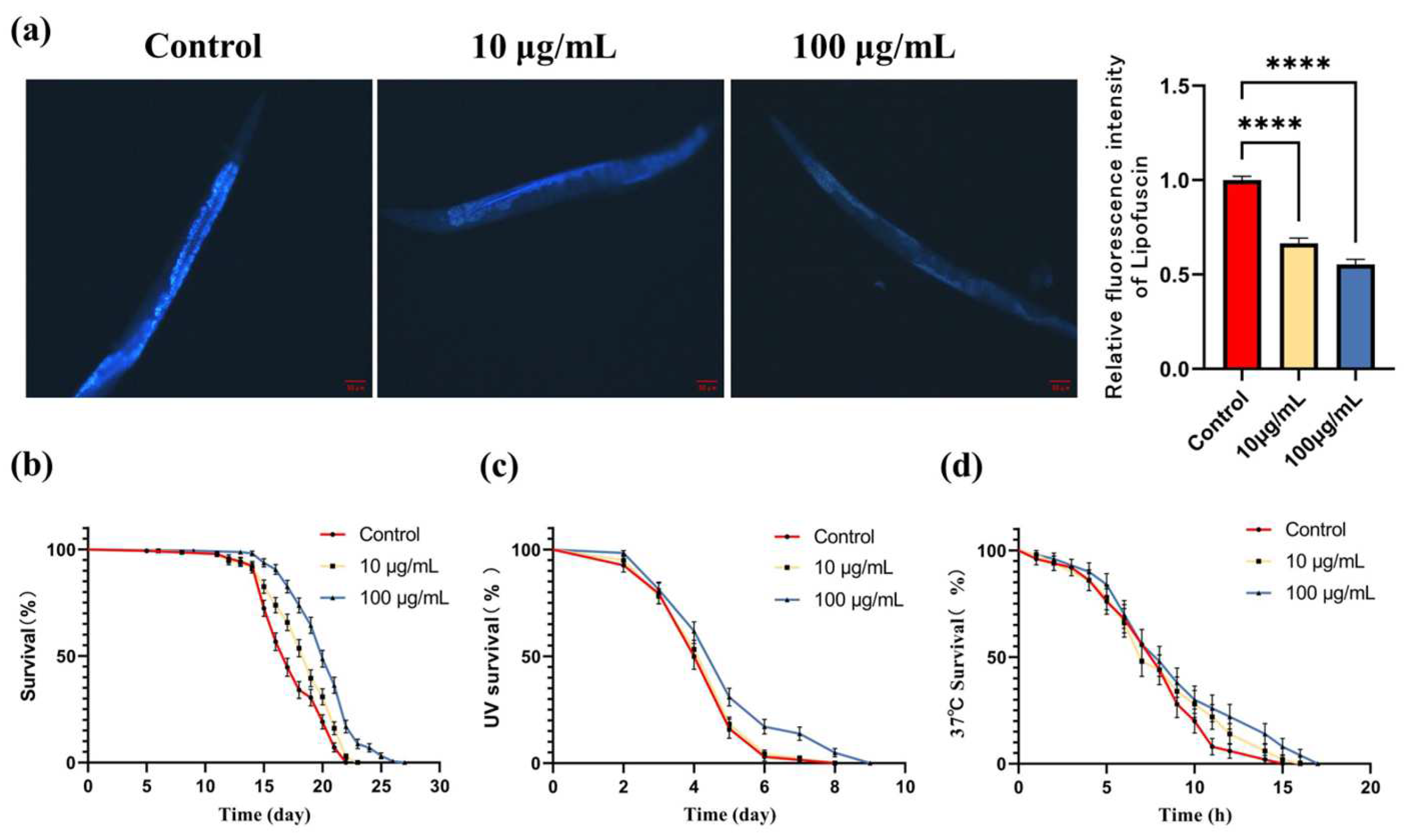
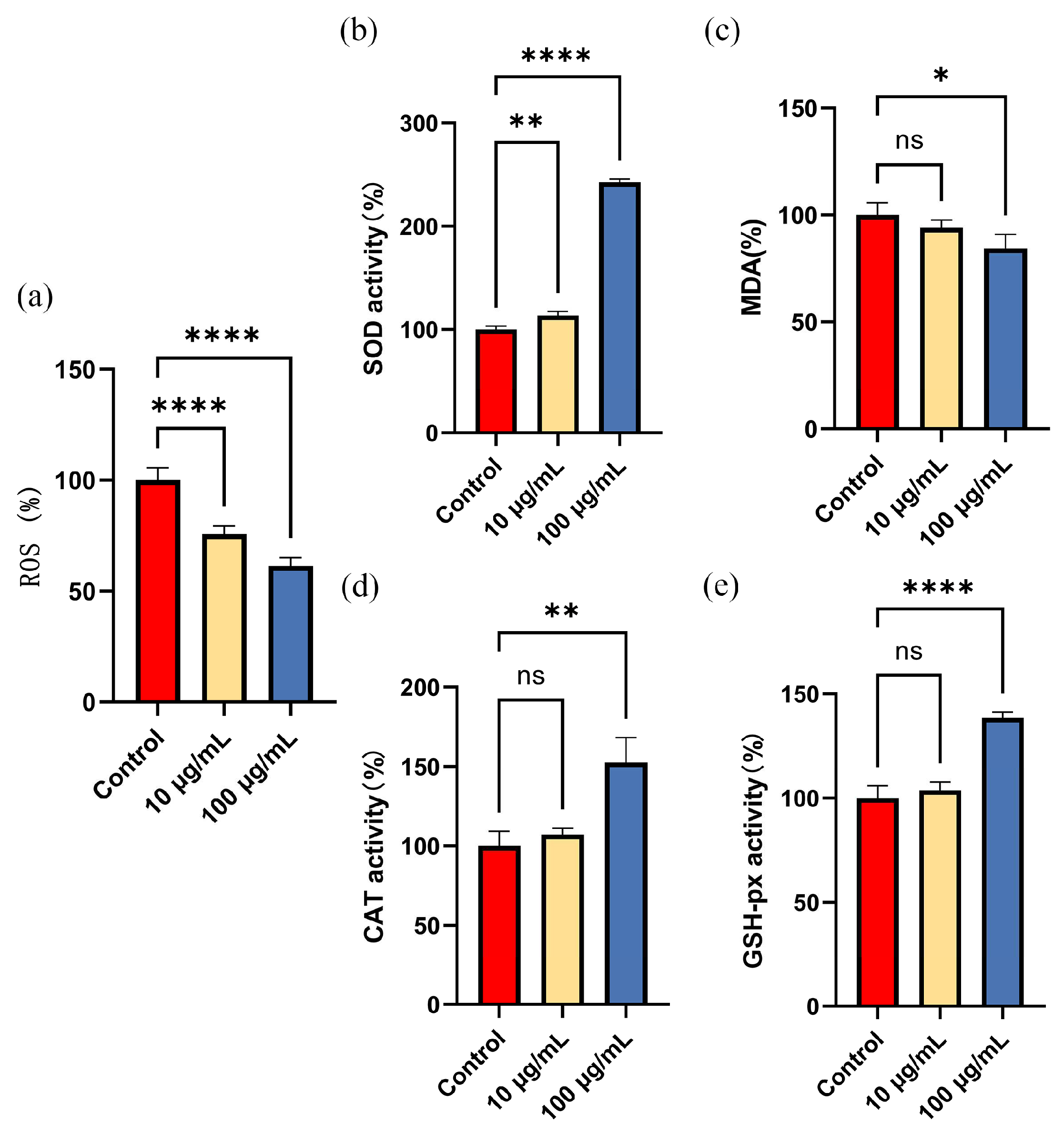
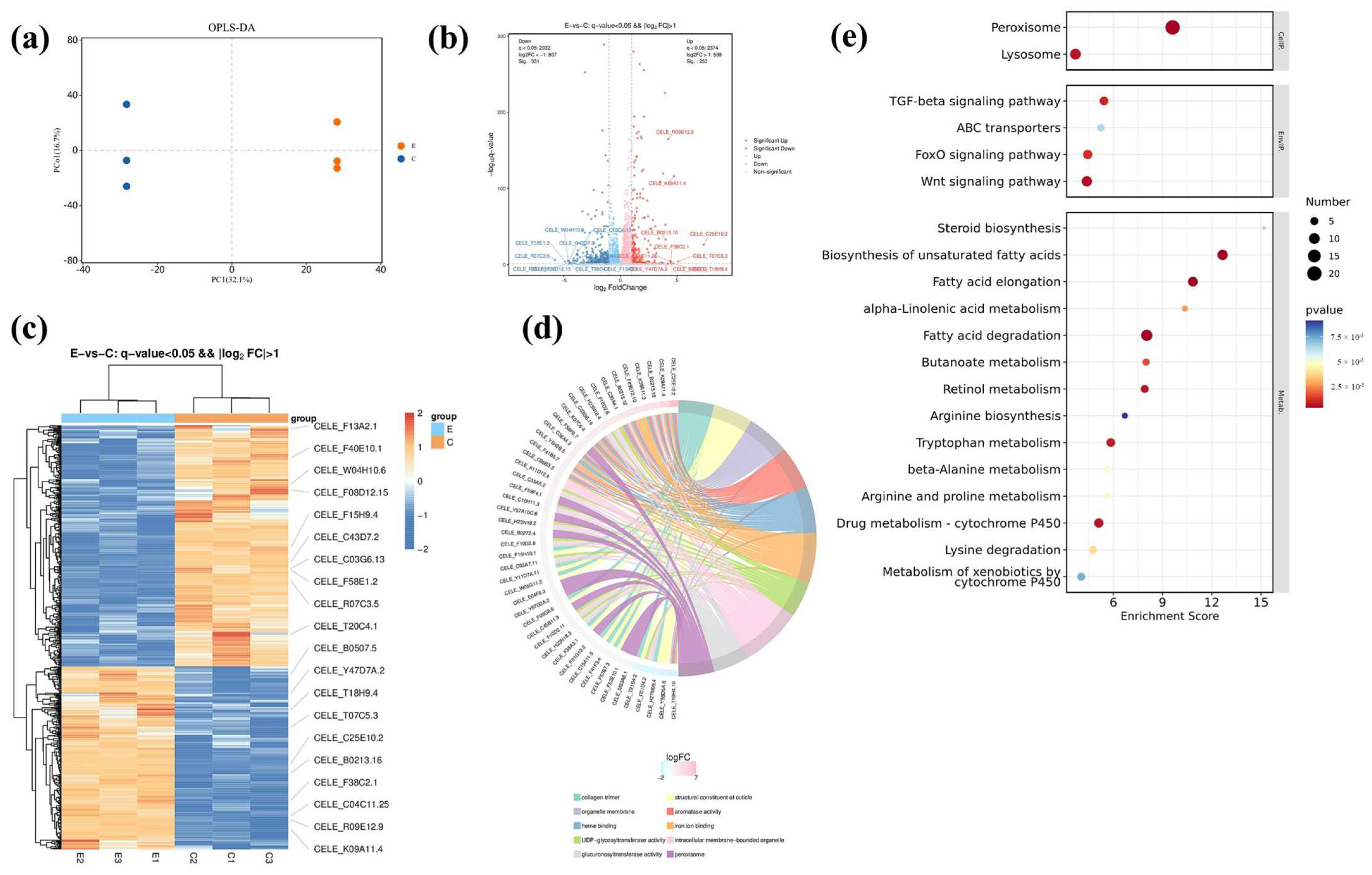
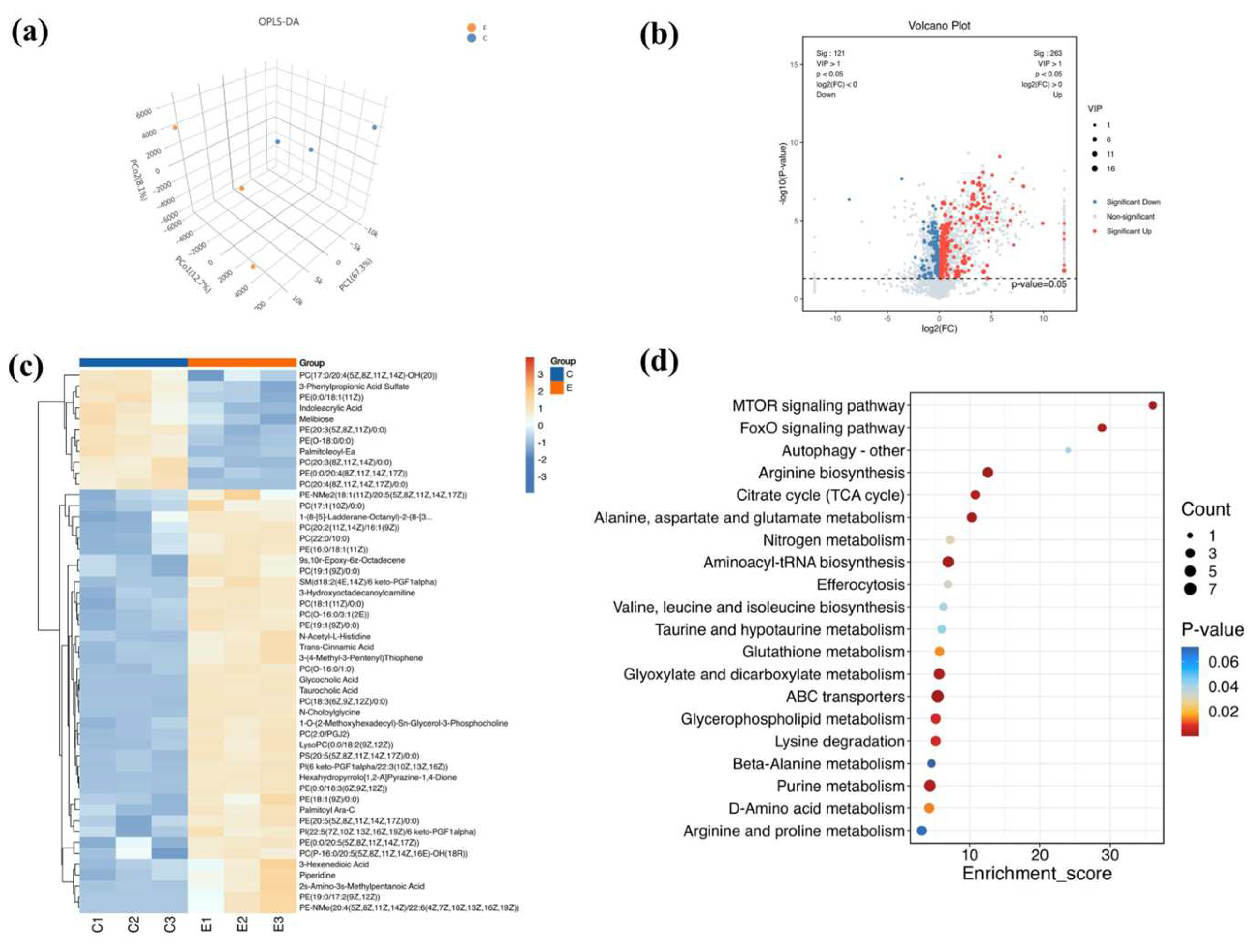

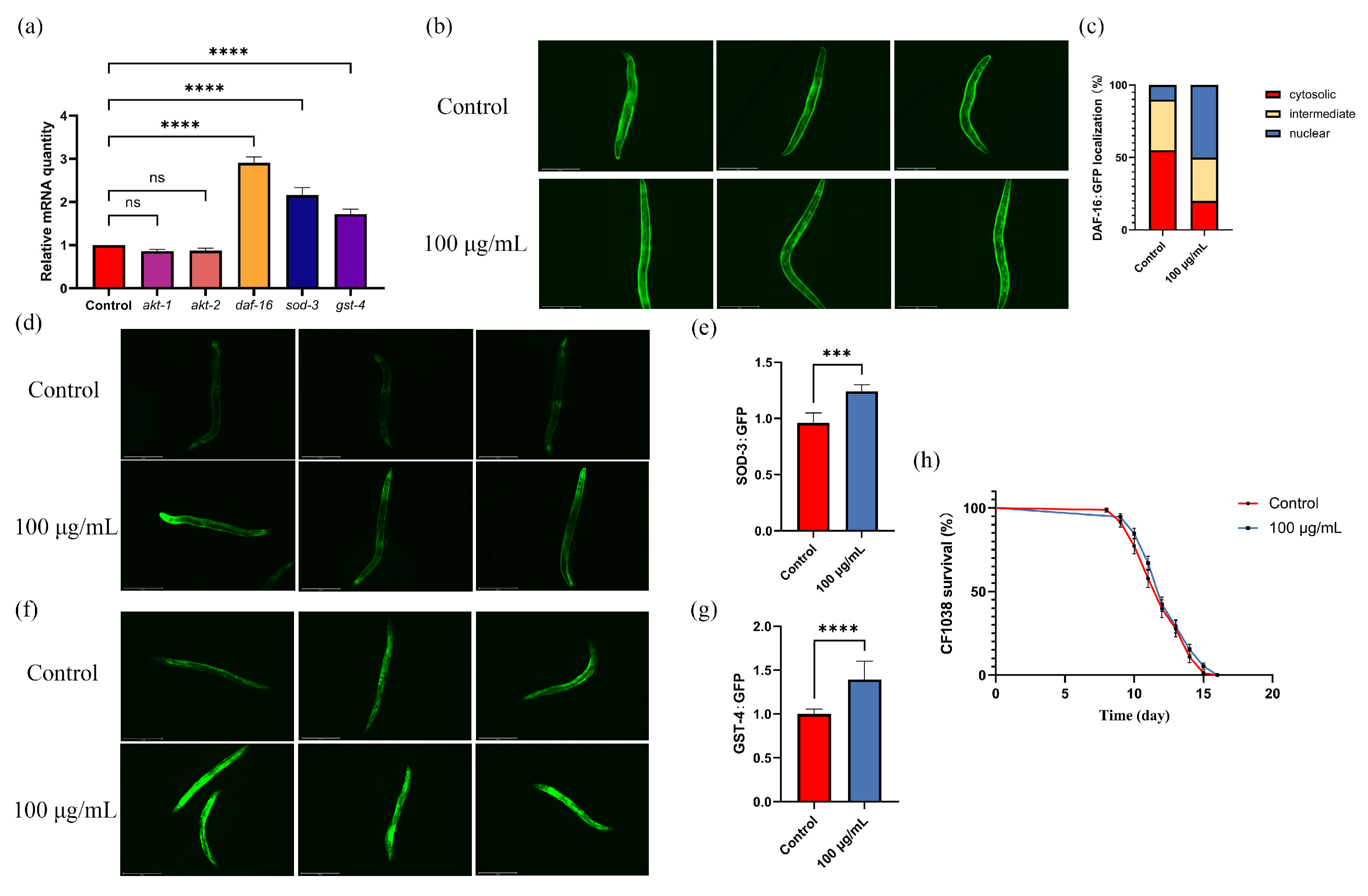
| Components | RT (Min) | Precursor m/z | Reference m/z | Error (ppm) | Adduct | Formula |
|---|---|---|---|---|---|---|
| (5E)-4-methoxy-5-[methoxy-[(2R,3S)-3-phenyloxiran-2-yl]methylidene]furan-2-one | 1.158633 | 273.10920 | 273.10904 | 0.586 | [M−H]− | C15H14O5 |
| 3-Methylxanthine | 1.24045 | 165.04170 | 165.04179 | 0.545 | [M−H]− | C6H6N4O2 |
| Arabinose | 1.24045 | 149.04580 | 149.04555 | 1.677 | [M−H]− | C5H10O5 |
| Carbetamide | 1.344417 | 237.12330 | 237.12337 | −0.295 | [M+H]+ | C12H16N2O3 |
| trans-5-O-Caffeoylquinic acid | 1.362117 | 353.10940 | 353.10901 | 1.104 | [M−H]− | C16H18O9 |
| N-Benzyloxycarbonylglycine | 4.972417 | 208.06190 | 208.06154 | 1.730 | [M−H]− | C10H11NO4 |
| N-Isovalerylglycine | 6.510334 | 158.08210 | 158.08226 | −1.012 | [M−H]− | C7H13NO3 |
| 3Alpha-Hydroxy-3-Deoxyangolensic acid methyl ester | 6.676167 | 471.24510 | 471.24536 | −0.552 | [M−H]− | C27H36O7 |
| Okaramine J_120151 | 6.780283 | 525.28610 | 525.28601 | 0.171 | [M+H]+ | C32H36N4O3 |
| (2S,3R,4S,5S,6R)-2-[[(1S,4aR,7aS)-7-(hydroxymethyl)-1,4a,5,7a-tetrahydrocyclopenta[c]pyran-1-yl]oxy]-6-(hydroxymethyl)oxane-3,4,5-triol | 6.883483 | 329.12400 | 329.12418 | −0.547 | [M−H]− | C15H22O8 |
| Cytisine | 6.903934 | 229.06770 | 229.06781 | −0.480 | [M+H]+ | C11H14N2O |
| 4-acetyloxy-8-(3-oxo-2-pent-2-enylcyclopenten-1-yl) octanoic acid | 7.344133 | 349.11430 | 349.11429 | 0.029 | [M−H]− | C20H30O5 |
| 4-[2-[(1R,4aS,5R,6R,8aS)-6-hydroxy-5-(hydroxymethyl)-5,8a-dimethyl-2-methylidene-3,4,4a,6,7,8-hexahydro-1H-naphthalen-1-yl]-1-hydroxyethyl]-2H-furan-5-one | 7.344133 | 349.11460 | 349.11481 | −0.602 | [M−H]− | C20H30O5 |
| MBOA | 7.428117 | 164.03480 | 164.03461 | 1.158 | [M−H]− | C8H7NO3 |
| 5,6-dihydropenicillic acid | 7.428117 | 170.98500 | 170.98529 | −1.696 | [M−H]− | C8H12O4 |
| 1,4-Cyclohexanedicarboxylic acid | 7.470117 | 171.06640 | 171.06628 | 0.701 | [M−H]− | C8H12O4 |
| Communesin-B | 7.484583 | 509.29140 | 509.29108 | 0.628 | [M+H]+ | C32H36N4O2 |
| Meglutol | 7.880767 | 161.04580 | 161.04555 | 1.552 | [M−H]− | C6H10O5 |
| 2-[5-[2-[2-[5-(2-hydroxypropyl)oxolan-2-yl]propanoyloxy]propyl]oxolan-2-yl]propanoic acid | 8.028216 | 409.21950 | 409.21967 | −0.415 | [M+H]+ | C20H34O7 |
| Wikstromol | 8.238367 | 307.15160 | 307.15158 | 0.065 | [M+H]+ | C15H24O5 |
| Melatonin | 8.245916 | 231.12240 | 231.12207 | 1.428 | [M−H]− | C13H16N2O2 |
| Isopropylmalic acid | 8.733883 | 175.05960 | 175.05991 | −1.771 | [M−H]− | C7H12O5 |
| Caffeine | 9.06815 | 217.07030 | 217.07001 | 1.336 | [M+H]+ | C8H10N4O2 |
| 15,17-dihydroxy-9-methyl-4,10-dioxatricyclo [11.4.0.0,]heptadeca-1(17),13,15-triene-2,11-dione | 9.096033 | 305.10300 | 305.10306 | −0.197 | [M−H]− | C16H18O6 |
| (3,4,5-trihydroxy-6-methyloxan-2-yl) 2-(methylamino)benzoate | 9.4975 | 296.11350 | 296.11395 | −1.520 | [M−H]− | C14H19NO6 |
| MITOMYCIN C | 9.4975 | 333.12020 | 333.12045 | −0.750 | [M−H]− | C15H18N4O5 |
| Beclomethasone dipropionate | 9.5138 | 521.23270 | 521.23297 | −0.518 | [M+H]+ | C28H37CO7 |
| Indole-3-acetyl-L-glutamic acid | 9.577333 | 303.09860 | 303.09863 | −0.099 | [M−H]− | C H16N2O5 |
| 3′,5′-Dimethoxy-4′-hydroxyacetophenone | 9.617333 | 195.06640 | 195.06628 | 0.615 | [M−H]− | C10H12O4 |
| 3-hydroxy-2-octylpentanedioic acid | 9.698167 | 259.15520 | 259.15509 | 0.424 | [M−H]− | C13H24O5 |
| methyl 2-benzamido-3-phenylpropanoate | 9.698167 | 282.11370 | 282.11356 | 0.496 | [M−H]− | C17H17NO3 |
| FERULATE | 9.82215 | 193.05020 | 193.05000 | 1.036 | [M−H]− | C10H10O4 |
| [4-[3,4,5-trihydroxy-6-(hydroxymethyl)oxan-2-yl]oxyphenyl]methyl 3-acetyloxy-2-hydroxy-2-[(4-hydroxyphenyl)methyl]butanoate | 9.846617 | 575.15250 | 575.15253 | −0.052 | [M+H]+ | C26H32O12 |
| Shikimic acid | 10.37175 | 197.04200 | 197.04204 | −0.203 | [M+H]+ | C7H10O5 |
| Alverine citrate | 10.41242 | 282.22160 | 282.22198 | −1.346 | [M+H]+ | C26H35NO7 |
| [3-(4-hydroxy-3-methoxybenzoyl)-2,3-dimethyloxiran-2-yl]-(4-hydroxy-3-methoxyphenyl)methanone | 10.42645 | 371.07480 | 371.07471 | 0.243 | [M−H]− | C20H20O7 |
| C17_Sphingosine | 10.65907 | 286.27370 | 286.27399 | −1.013 | [M+H]+ | C17H35NO2 |
| 3-[(2S,3R,4S,5S,6R)-4,5-dihydroxy-6-(hydroxymethyl)-3-[(2S,3R,4S,5R)-3,4,5-trihydroxyoxan-2-yl]oxyoxan-2-yl]oxy-5,7-dihydroxy-2-(4-hydroxyphenyl)chromen-4-one | 11.07492 | 579.15290 | 579.15253 | 0.639 | [M−H]− | C26H28O15 |
| Styrene | 11.29803 | 105.06960 | 105.06988 | −2.665 | [M+H]+ | C8H8 |
| Mollugin | 11.49802 | 307.10000 | 307.10001 | −0.033 | [M+H]+ | C17H16O4 |
| Pesticide3_Bifenazate_C17H20N2O3_1-Methylethyl 2-(4-methoxybiphenyl-3-yl)hydrazinecarboxylate | 11.53785 | 301.15370 | 301.15399 | −0.963 | [M+H]+ | C17H20N2O3 |
| 8-acetamido-2-methyl-7-oxononanoic acid | 11.59707 | 242.13950 | 242.13977 | −1.115 | [M−H]− | C12H21NO4 |
| [(3aS,4S,5S,6E,10Z,11aR)-6-formyl-5-hydroxy-10-(hydroxymethyl)-3-methylidene-2-oxo-3a,4,5,8,9,11a-hexahydrocyclodeca[b]furan-4-yl] 2-methylprop-2-enoate | 11.65785 | 401.09960 | 401.09970 | −0.249 | [M+H]+ | C19H22O7 |
| Licoagroside B (Not validated) | 11.75722 | 431.11870 | 431.11880 | −0.232 | [M−H]− | C18H24O12 |
| Scytophycin B | 12.05967 | 842.50730 | 842.50702 | 0.332 | [M+H]+ | C45H73NO12 |
| [5-hydroxy-3-(hydroxymethyl)-2-oxo-6-propan-2-ylcyclohex-3-en-1-yl] 3-methylpentanoate | 12.39685 | 297.17090 | 297.17075 | 0.505 | [M−H]− | C16H26O5 |
| Chrysanthemic acid, ethyl ester | 12.756 | 195.13920 | 195.13905 | 0.769 | [M−H]− | C12H20O2 |
| (2R)-2-[(2R,5S)-5-[(2S)-2-hydroxybutyl]oxolan-2-yl]propanoic acid | 12.83583 | 215.12860 | 215.12888 | −1.302 | [M−H]− | C11H20O4 |
| DGMG 18:3 | 13.1938 | 721.36410 | 721.36407 | 0.042 | [M−H]− | C33H56O14 |
| MEGxp0_001388 | 15.65933 | 955.29820 | 955.29828 | −0.084 | [M−H]− | C41H32O27 |
| 2-[4a-methyl-8-methylidene-4-(3-methylpentanoyloxy)-1,2,3,4,5,6,7,8a-octahydronaphthalen-2-yl]prop-2-enoic acid | 15.94167 | 347.22250 | 347.22278 | −0.806 | [M−H]− | C21H32O4 |
| 2-(8-hydroxyoctyl)-6-methoxybenzoic acid | 15.98182 | 279.15920 | 279.15900 | 0.716 | [M−H]− | C16H24O4 |
| Phosphatidylinositol 16 | 15.98182 | 857.51860 | 857.51855 | 0.058 | [M−H]− | C45H79O13P |
| Carylophyllene oxide | 16.02265 | 205.15980 | 205.15977 | 0.146 | [M−H]− | C14H22O |
| Roccellic acid | 16.06382 | 299.22230 | 299.22278 | −1.604 | [M−H]− | C17H32O4 |
| Lauric acid | 16.30847 | 199.17040 | 199.17035 | 0.251 | [M−H]− | C12H24O2 |
| 4-({5-[5-hydroxy-3-({[(2Z)-2-methylbut-2-enoyl]oxy}methyl)pentyl]-8a-(hydroxymethyl)-5,6-dimethyl-3,4,4a,5,6,7,8,8a-octahydronaphthalen-1-yl}methoxy)-4-oxobutanoic acid | 16.67412 | 521.31180 | 521.31195 | −0.288 | [M−H]− | C29H46O8 |
| Ketoisovaleric acid | 18.08483 | 117.05470 | 117.05462 | 0.683 | [M+H]+ | C5H8O3 |
| Isopalmitic Acid | 18.32648 | 257.24750 | 257.24750 | 0.000 | [M+H]+ | C16H32O2 |
| FA 18:1+3O | 18.38903 | 329.23240 | 329.23251 | −0.334 | [M−H]− | C18H34O5 |
| Grossamide or its isomer (not validated) | 18.97012 | 625.25680 | 625.25671 | 0.144 | [M+H]+ | C36H36N2O8 |
| Heptadecanoic acid | 19.17193 | 271.26040 | 271.26001 | 1.438 | [M+H]+ | C17H34O2 |
| (E)-5-[(1S,4aR,8aR)-2-formyl-5,5,8a-trimethyl-1,4,4a,6,7,8-hexahydronaphthalen-1-yl]-3-(acetyloxymethyl)pent-2-enoic acid | 19.32013 | 375.27600 | 375.27643 | −1.146 | [M−H]− | C22H32O5 |
| 6-Hydroxycaproic acid | 19.77323 | 133.08550 | 133.08592 | −3.156 | [M+H]+ | C6H12O3 |
| Avocadene 4-acetate | 20.71465 | 327.25420 | 327.25406 | 0.428 | [M−H]− | C19H36O4 |
Disclaimer/Publisher’s Note: The statements, opinions and data contained in all publications are solely those of the individual author(s) and contributor(s) and not of MDPI and/or the editor(s). MDPI and/or the editor(s) disclaim responsibility for any injury to people or property resulting from any ideas, methods, instructions or products referred to in the content. |
© 2024 by the authors. Licensee MDPI, Basel, Switzerland. This article is an open access article distributed under the terms and conditions of the Creative Commons Attribution (CC BY) license (https://creativecommons.org/licenses/by/4.0/).
Share and Cite
Xu, P.; Wang, J.; Wang, J.; Hu, X.; Wang, W.; Lu, S.; Sheng, Y. Anoectochilus roxburghii Extract Extends the Lifespan of Caenorhabditis elegans through Activating the daf-16/FoxO Pathway. Antioxidants 2024, 13, 945. https://doi.org/10.3390/antiox13080945
Xu P, Wang J, Wang J, Hu X, Wang W, Lu S, Sheng Y. Anoectochilus roxburghii Extract Extends the Lifespan of Caenorhabditis elegans through Activating the daf-16/FoxO Pathway. Antioxidants. 2024; 13(8):945. https://doi.org/10.3390/antiox13080945
Chicago/Turabian StyleXu, Peng, Jianfeng Wang, Junyi Wang, Xiaoxiao Hu, Wei Wang, Shengmin Lu, and Yingkun Sheng. 2024. "Anoectochilus roxburghii Extract Extends the Lifespan of Caenorhabditis elegans through Activating the daf-16/FoxO Pathway" Antioxidants 13, no. 8: 945. https://doi.org/10.3390/antiox13080945







